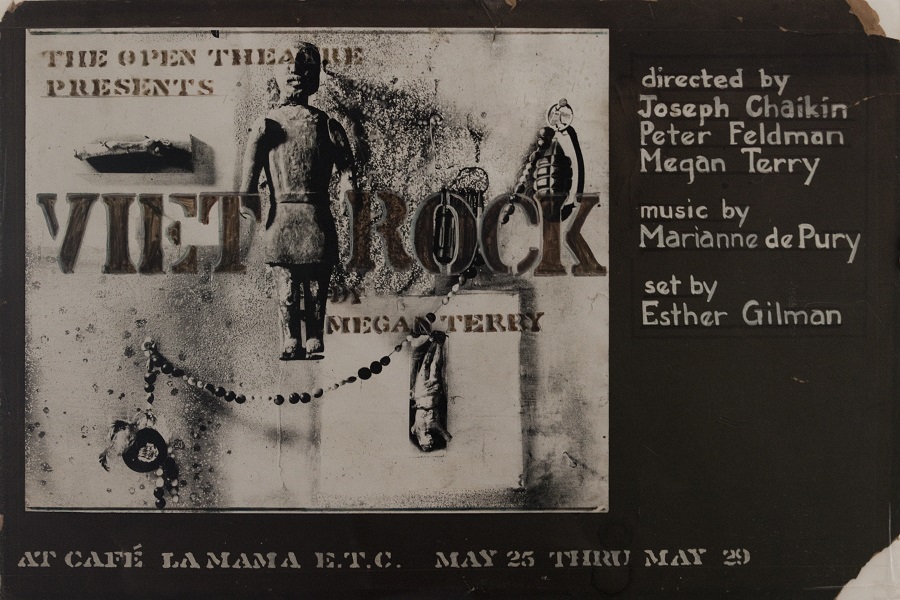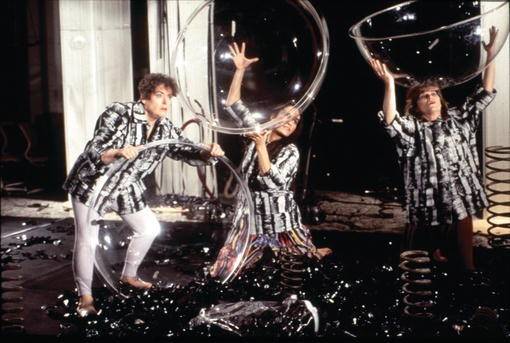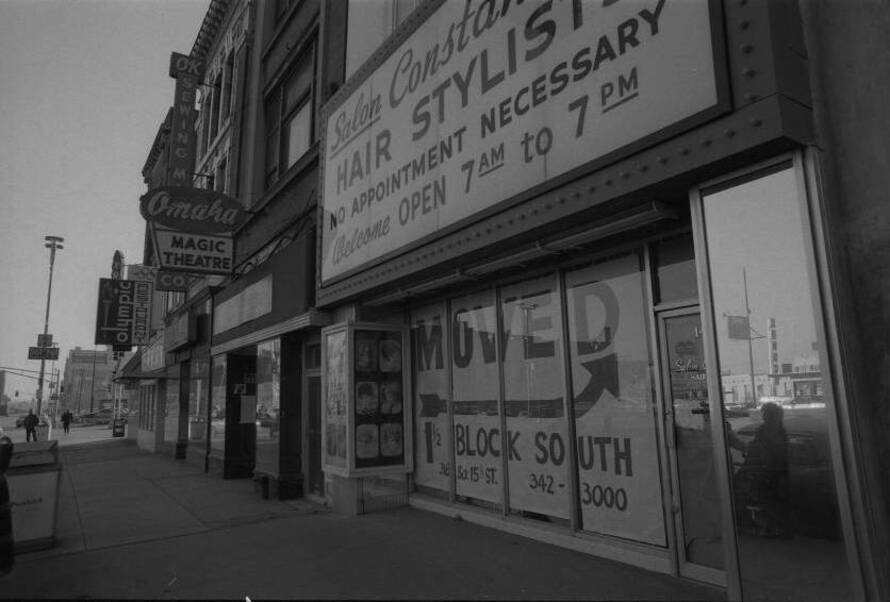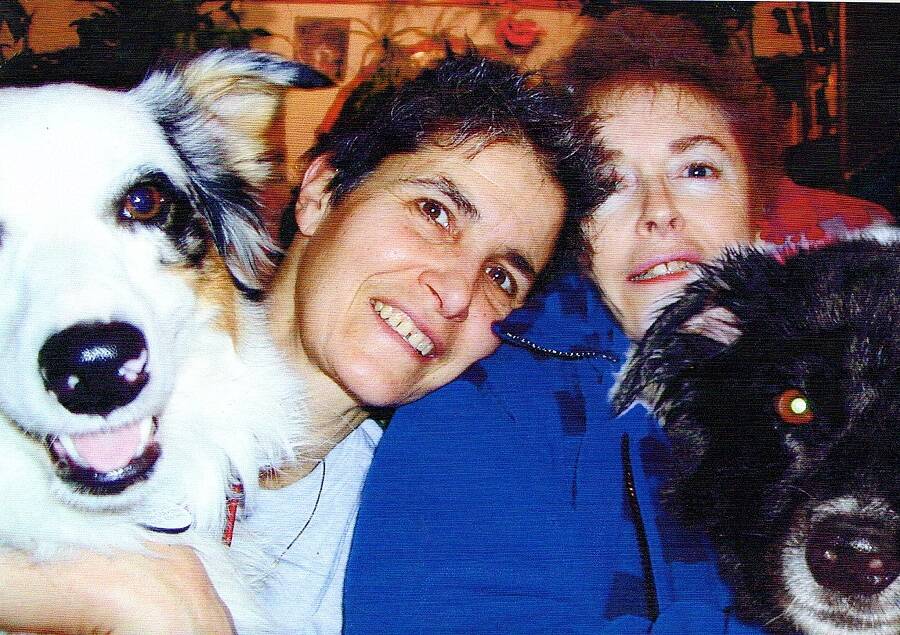You may not associate artists in the vanguard of American experimental theatre with Omaha, Neb., but that’s where Open Theater alums Megan Terry and Jo Ann Schmidman currently reside.
Few residents of the downtown neighborhood they live in likely know about their revolutionary legacy or the world-class creative circles they ran in. To the uninitiated, Terry and Schmidman are just a mildly eccentric lesbian couple with an overgrown front yard obscuring their Mother Hubbard home.
Visiting them at their art-filled, book-lined abode, you’re greeted by the three large dogs Schmidman trains. The women share the easy rapport of longtime companions who finish each other’s sentences. Terry, still a vital presence at 89, fixes on you with a soft but searching gaze. Schmidman, 74, regards you with inscrutable curiosity. Just as neither has a need to be in the spotlight anymore, there’s no hint of regret that they largely walked away from the theatre two-plus decades ago.
“The art of living,” Schmidman says, became their creative expression. Their dogs, gardening, working out, and dealing with business affairs is plenty to occupy their time. Terry’s plays still get produced, and new translations continue to be made.
Terry, originally from Washington state, was inspired to write plays after reading the work of Samuel Beckett and Gertrude Stein. In Seattle she revived the Cornish Players at the Cornish School of Allied Arts, but soon faced board-driven challenges to her vision. So she packed up her Chevy for New York City.
“I said, ‘Goodbye—I’m going someplace else, where I can do what I want to do,’” she recalls.
Her break came in the late 1960s when Terrence McNally selected her play Ex-Miss Copper Queen on a Set of Pills to accompany one of his own plays on a bill off-Off-Broadway. Joseph Chaikin and Michael Smith saw it. Terry recalls that Chaikin “hated the production but loved the writing. He said, ‘We’re thinking of starting a theatre and we’re looking for writers, are you interested?’ There they were, my dream boys, and we were off to the races.”

With Chaikin, Smith, and others she co-founded the Open Theater, which broke with tradition by celebrating subversive, non-linear work. La MaMa’s Ellen Stewart championed this new wave of playwrights, who upended theatrical and social conventions and exposed injustices. Terry soon became a darling of the avant-garde, alongside such luminaries as María Irene Fornés, Susan Yankowitz, Sam Shepherd, and Lanford Wilson. Her pieces played Cafe La MaMa and Caffe Cino.
“How lucky we were to be alive and working then,” Terry recalls. “Going to see all these plays by these wonderful writers, God, was inspiring, thrilling. It was like playing a game of, ‘Can you top this?’ Whoever had a new play, everybody was there.”
Her Viet Rock, which some consider to have been both the first rock musical and the first Vietnam War-themed theatre work, was must-see Off-Broadway in the mid-1960s. It influenced the creators of Hair, who workshopped their musical alongside hers. Experimental icon Robert Wilson suggested hanging fresh laundry over the audience for Viet Rock.
Edgy theatre, Terry said, was the place to be if you wanted to see art that was speaking with immediacy to the times.
“When I did Calm Down Mother and Keep Tightly Closed on a double bill at the Cherry Lane, half the audience hated it and half loved it,” Terry recalls. “They put me up against the wall in the lobby, screaming, ‘What are you trying to do us?’”
“Because it mattered,” Schmidman chimes in.
“It really mattered to the audience,” Terry agrees. “It was an amazing time.”
Schmidman, an Omaha native, got bit by the theatre bug attending Broadway touring musicals in New York and Kansas City, Mo. After stints in children’s theatre and an adventurous wing of the Omaha Community Playhouse, she studied at Northwestern University and Boston University. But before long she was drawn to the work of groundbreakers like Terry and Chaikin. In 1968 she founded the Omaha Magic Theatre, modeling it on the Open Theater.
Starting Omaha’s first experimental theatre at age 20 didn’t seem risky to her at time time, she says. “There is something incredibly expansive about this area and about the people that live here,” she reasons. “The extremes of temperature, I believe, allow extremes of creation.”
She soon joined the ferment of the NYC scene as an Open Theater actor, performing in the company’s final play, 1973’s Nightwalk, co-scripted by Jean-Claude van Itallie, Sam Shepard, and Terry. She toured the world with it. She also starred in Terry’s Obie-winning play Approaching Simone.
The two women’s adventurous spirits found each other at a 1969 anti-war rally on the Boston Common. Schmidman, still a BU student, was doing guerrilla theatre wearing a tin foil mask, while Terry, godmother of radical women playwrights, was a visiting artist on her way to hear Howard Zinn speak. Recalls Terry, “Jo Ann was in the middle of a wood on the way to this massive protest and her mask came off and fell down. I picked it up. ‘Do you want to keep wearing this?’ Her hair was clear down to her bottom. Fantastic.”
Making Magic in Omaha
The pair lived together in the Village and held workshops in Terry’s loft. During breaks from her Open Theater schedule, Schmidman revisited her Magic Theatre in Omaha. Terry sometimes joined her. When the Open Theater closed, the two settled in the Midwest to create new work together, with Terry as resident playwright and Schmidman as resident director. Both acted in productions. Schmidman developed into a playwright in her own right.
Decades before today’s movement for gender parity in the theatre, Terry and Schidman produced their own original work and that of others, like Paula Vogel (Baby Makes Seven) and Fornés, who came to Omaha to direct her play Mud.
Terry embraced making new theatre in Nebraska. “I was very interested in this community and what these people were about,” she says.
Schmidman says she knew Terry would be a good fit. “She came to work with a company. That was her calling—to make theatre for others. You sort of couldn’t do that in New York as well or as easily.”
Besides, Terry explains, “the magic” was wherever they hung their hats. Their community-based, imagistic theatre, rooted in exploration and in presenting things in boundary-pushing ways, found receptive audiences in that conservative state. Feminist, queer, and other social themes permeated the work, though they say the theatre never branded its shows with identity politics labels.
“We, believe me, didn’t name it,” Schmidman ways. “We were honest, truthful. But it wasn’t a gay statement when we did Babes in the Big House with an all-male cast. In my brain, it became one. We wanted to do a play about women in prison and our company was practically 80 percent male at that time. So what are you going to do? The men did it and it was fabulous.”
“The audience could understand what women go through by seeing men go through what women did,” Terry says.

“We would never proselytize,” Schmidman continues. “I wasn’t interested in political theatre per se; I was interested in making it very personal, then it became political in a stronger sense. I think that’s what all of Megan’s plays absolutely have. We always built theatre…”
“…that dealt with our deep feelings and deep observations of the world,” Terry interjects, finishing her partner’s thought. “And what we had to live with. It was about everything—it was about being a human being.”
The women toured their work across Nebraska, the Midwest, as well as nationally and internationally, and traveled extensively to do workshops, residencies, and lectures at colleges and universities.
But while they felt free to create edgy work in Omaha, their theatre never received the full support it would have needed to continue. The Magic Theatre officially closed in 1998 after 30 years in operation; both women say they were exhausted by endless fundraising cycles, and local corporate support never materialized. Though they were never told to their faces, presumably the town’s buttoned-down types regarded their plays as too far out.
“It didn’t get easier,” Schmidman says. “There was no sugar daddy saying, ‘Oh, what brilliant work, don’t think about writing another grant, I’ll take care of it.’ It never happened.”
But Terry continued writing and accepting commissions, while Schmidman consulted emerging artists. Looking back on it all now, from the vantage point of 2022, with the reversal of Roe, the specter of Trumpism, and daily reports of mass shootings, even these two surrealists find the real world a bit—well, surreal.
“Can you believe it?” Schmidman marvels. “I mean, you can’t do theatre about it, even because it’s not believable.”
“It’s beyond absurd,” says Terry.
Schmidman continues: “My therapist says it’s the truth we have to understand before we can change something or work on changing something. Instead of just saying it’s out of whack, which is my inclination, we have to embrace it as the truth.”
She wonders if these “weird times” might “give birth to a new theatre. That’s what happened in the ’60s, right?”
“We have to start all over again,” answers Terry.
One place to start: not necessarily in New York. Terry says her former colleague, Joe Chaikin, used to lament that too much theatre was about real estate. “That’s why he hated Broadway. He wanted to destroy Broadway. That used to be Chaikin’s monologue.”

“A vital new theatre,” Schmidman says, “certainly doesn’t need to be tied to real estate. There are new dumps in every city where they can roll up their sleeves and get to work. It’s hard work is the thing.”
Omaha rents weren’t as prohibitive as New York’s, but even so, Schmidman says she often negotiated rent-free stays at her building. Company members sometimes lived communally, and Terry dumpster-dived to salvage food from a four-star French restaurant.
There are other tips that small theatres could take from Magic’s example. On building an audience: Schidman says that the steel fabricators and paper manufacturers whose products were used in productions “wanted to see how their goods were transformed into art,” Schmidman said. “We built theatre around them.”
Another audience-loyalty tip: They let folks pay once and see a show multiple times.
But they didn’t just make theatre in Omaha for the low rents. They link their DIY ethic to the creatives, dreamers, and doers in their families.
“The pioneering spirit and the quest to work with your own hands, out of your own soul, is an Omaha, a Midwestern trait, and that’s exactly the kind of theatre I was interested in doing,” Schmidman says. “It didn’t have anything to do with being radical; it had to do with being homemade and what is inside of people. It wasn’t about shocking people; it was about giving them a vehicle to reflect, a way to understand one’s self better, to go on a spiritual journey.”
That self-discovery, crucially, could be shared with others.
“For us, it was thinking if we look deeply enough inside, we could share with audiences something that would go deep inside them,” Schmidman says.
That searching spirit informed not only the work on their stage but how they ran the theatre.
“What part of patriarchy do you take on?” Schmidman asks rhetorically. “Having a board that tells you what to do—is that a part of corporate America the arts should subscribe to? I don’t think so. I knew that we couldn’t go there. We would have sold out. They would have determined what was on that stage.”
She advises theatremakers to remain independent. “They need to get out there, roll up their sleeves, start making their art, and not have fat-ass boards. Don’t give ’em that power.”
Theatre, they suggest, can be part of healing America’s divisions. Says Terry: “We have to reconcile the different groups and accept one another.” Schmidman adds: “Theatre is the great unifier. If we were still making theatre, the pieces would be about living and loving.”
An archive of Magic Theatre’s work is housed at the University of California-Berkeley’s Bancroft Library, and Terry’s New York plays are part of the Open Theater archive at Kent State in Ohio. The 1975 book Three Works by the Open Theater includes Nightwalk and production stills.
The 1992 book Right Brain Vacation Photos chronicles two decades of the Magic Theatre.
Leo Adam Biga (he/him) is an Omaha-based freelance writer and the author of the 2016 book Alexander Payne: His Journey in Film.



